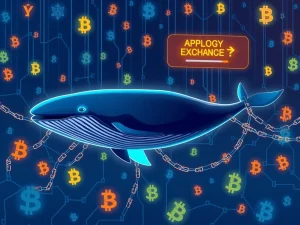XRP News: Ripple CTO Unveils Crucial Details on Missing 32,000 XRP Ledger Blocks, Prioritizing Blockchain Integrity

The world of cryptocurrency is often filled with innovation, but also with intriguing technical challenges. Recently, a significant discussion has emerged within the XRP community concerning a peculiar anomaly: the absence of the first 32,000 blocks in the XRP Ledger. This isn’t just a minor glitch; these blocks represent the very genesis of the network, holding critical early transaction history. For anyone invested in or following XRP News, understanding the implications of this discovery and Ripple’s response is paramount.
Understanding the Missing XRP Ledger Blocks: What Happened?
Concerns about the initial 32,000 blocks of the XRP Ledger first surfaced prominently in July 2025. These missing blocks, representing approximately 10 days of the ledger’s very first operations, have naturally led to questions about data integrity and whether this was an intentional deletion or a systemic flaw. The XRP Ledger currently begins at block 32,570, meaning a significant chunk of its foundational history is not publicly accessible in the expected sequence.
This situation has been a focal point of discussion, prompting the community to seek clarity from Ripple, the company closely associated with the development and promotion of XRP. The core of the issue revolves around ensuring the transparency and immutability that are hallmarks of blockchain technology, especially when dealing with the very earliest records of a decentralized network.
Ripple CTO’s Unwavering Stance: Prioritizing Blockchain Integrity
Addressing these community concerns head-on, David Schwartz, the esteemed Ripple CTO, provided a transparent explanation for the anomaly. He confirmed that the absence of these initial blocks was not due to malicious activity or an intentional deletion, but rather stemmed from a software error during the network’s early testing phase. Schwartz emphasized that the loss was unintentional and a result of the technical complexities inherent in developing a nascent blockchain system.
In a public statement, Schwartz clarified, “Existing data wasn’t deleted to prevent further loss. There was no way to recover the lost data.” This admission highlights the difficult choices developers face in the early stages of decentralized network deployment. The focus for the Ripple CTO was clearly on preserving the ongoing functionality and integrity of the ledger once the error was identified, rather than attempting a risky, potentially more disruptive, retroactive fix.
The Early Bug Explained: A Glimpse into XRP’s Origins
The software error occurred during a crucial, experimental period for the XRP Ledger. In the nascent days of any blockchain, extensive testing is conducted to identify and rectify vulnerabilities before full-scale deployment. This particular bug, however, resulted in the irretrievable loss of the first 32,000 blocks. It serves as a stark reminder of the challenges involved in pioneering new decentralized technologies, where even minor oversights in testing environments can leave permanent marks.
Schwartz’s explanation aims to provide a clear technical context for the issue, framing it as a one-time developmental flaw rather than an ongoing systemic vulnerability. This distinction is vital for maintaining trust in the network’s reliability, especially given the continuous flow of XRP News and market activity. The incident underscores the meticulous nature of blockchain development and the often-unforeseen consequences of early-stage bugs.
Why Not Reset? The Immutable Nature of Blockchain
A natural question arises: why not simply reset the blockchain to correct the error and start from scratch? The answer lies at the very core of blockchain principles: immutability. Schwartz explained that resetting the blockchain to address the initial error would have necessitated erasing all data beyond block 32,000, effectively compromising the entire subsequent history of the ledger. Such a drastic measure would undermine the fundamental trust in the system’s consistency and its promise of an unalterable record.
Instead, the development team opted to continue operating the system as is, prioritizing the security and continuity of all subsequent blocks over rectifying historical anomalies. This decision aligns with broader blockchain ethics, where altering past records – even for corrections – is generally avoided to maintain the cryptographic integrity and trustworthiness of the system. This commitment to Blockchain Integrity ensures that all transactions recorded since block 32,570 are verifiable and secure, forming an unbroken chain of trust.
Reassuring the Community: Trust in XRP’s Future
Despite the initial concerns surrounding the Missing XRP Blocks, the Ripple CTO has worked to reassure stakeholders about the ledger’s current operational status. Schwartz confirmed that the XRP Ledger has operated without disruptions since its public launch, with all post-32,000 blocks accurately recorded and verifiable through its robust consensus mechanisms and cryptographic validation. This means that while the very beginning of the ledger is incomplete, its ongoing operations are sound and secure.
Analysts and developers have largely interpreted Ripple’s admission as a transparent acknowledgment of developmental challenges. By framing the problem as a technical flaw rather than a systemic design flaw, Ripple aims to reinforce confidence in the XRP Ledger’s reliability. It’s also crucial to remember the distinction between the XRP Ledger’s technical governance, which is decentralized, and Ripple Labs’ corporate operations; the ledger processes transactions independently of the company’s business activities.
Lessons Learned: Enhancing Blockchain Development
This development underscores the paramount importance of rigorous testing in blockchain ecosystems. Early-stage bugs, even when corrected, can leave traceable artifacts, with missing blocks being a notable example. Ripple’s decision to retain the original ledger without modifications reflects a commitment to transparency, adhering to the principle that historical data should remain unaltered even if imperfect. This provides valuable insights for the broader blockchain industry on managing early-stage development issues.
The Ripple CTO‘s statements also highlight the inherent trade-offs in decentralized systems, where maintaining long-term Blockchain Integrity sometimes requires accepting historical imperfections to prevent larger, more disruptive interventions. This incident, while a minor historical footnote for the ledger, serves as a significant case study in transparency, immutability, and the practicalities of building robust decentralized networks.
The ongoing commitment to the XRP Ledger’s stability and security remains a top priority, ensuring its continued role in the evolving digital asset landscape. As the network matures, such early challenges contribute to a deeper understanding of blockchain resilience and the critical need for meticulous development practices.
Frequently Asked Questions (FAQs)
1. What exactly are the ‘missing’ 32,000 XRP Ledger blocks?
The first 32,000 blocks of the XRP Ledger, representing approximately 10 days of its initial operation, are not present in the publicly accessible ledger. This means the ledger effectively starts from block 32,570, and the earliest transaction history within those initial blocks is irretrievable.
2. Why are these blocks missing? Was it intentional?
According to Ripple CTO David Schwartz, the blocks are missing due to a software error that occurred during the XRP Ledger’s early testing and development phase. He confirmed that the loss was unintentional and not the result of malicious activity or deliberate deletion.
3. Why couldn’t Ripple simply ‘reset’ the blockchain to fix this?
Resetting the blockchain to re-include the missing blocks would have required erasing all data recorded after block 32,000. This would have compromised the integrity and immutability of the entire subsequent ledger, which is a core principle of blockchain technology. The team prioritized the continuity and security of the existing, validated ledger over a retroactive fix.
4. Does this issue affect the security or functionality of the current XRP Ledger?
No. David Schwartz has clarified that the issue does not reflect ongoing operational failures. The XRP Ledger has operated without disruptions since its public launch, and all blocks recorded after the initial 32,000 are accurately recorded and verifiable through its robust consensus mechanisms. The network’s current operations remain secure and functional.
5. What does this mean for XRP holders and the future of the XRP Ledger?
For XRP holders, this incident primarily serves as a historical anomaly rather than an ongoing concern. It highlights the transparency of Ripple in addressing past technical challenges. The commitment to blockchain integrity and the continued secure operation of the XRP Ledger reinforce confidence in its long-term viability and reliability.









